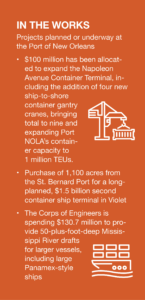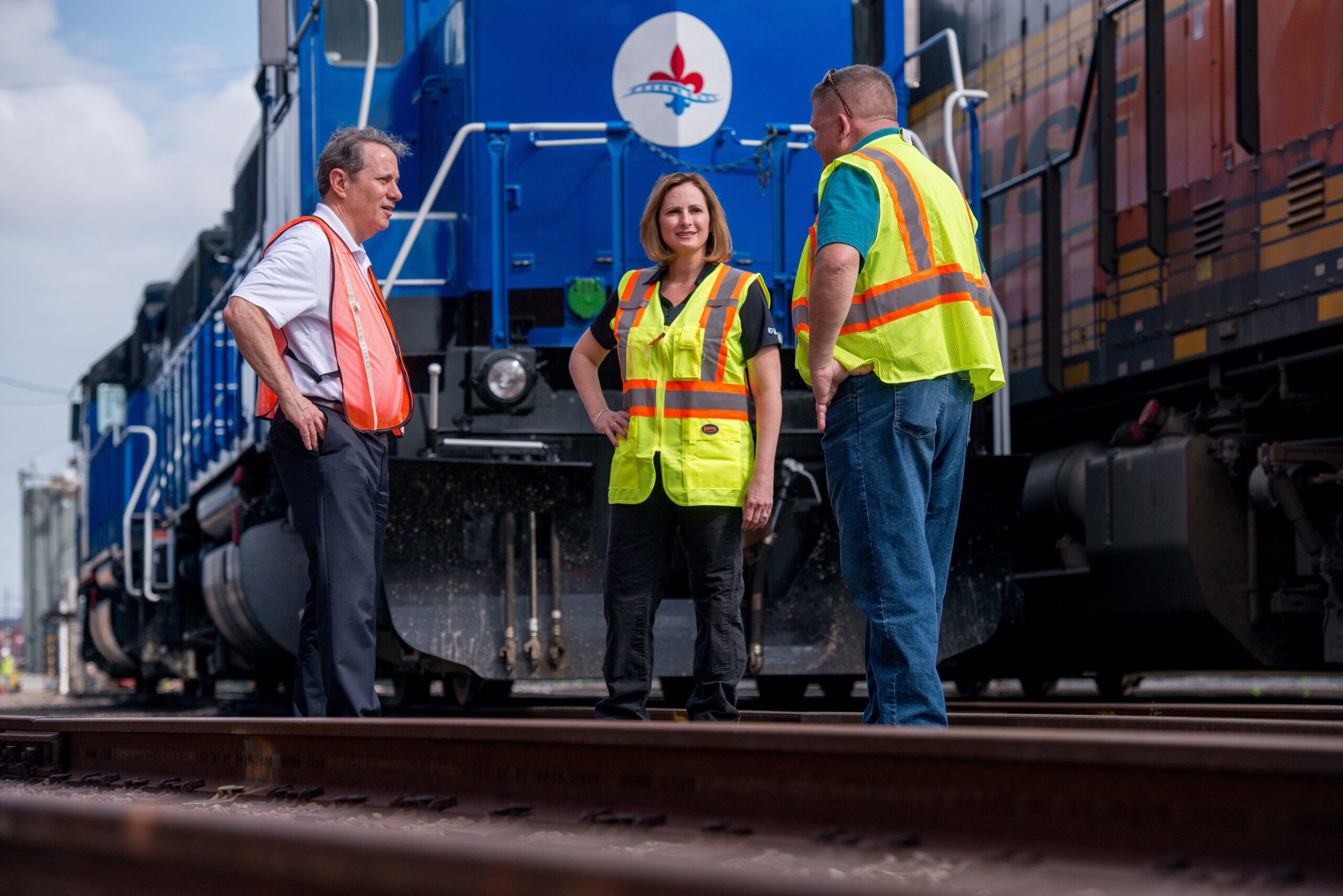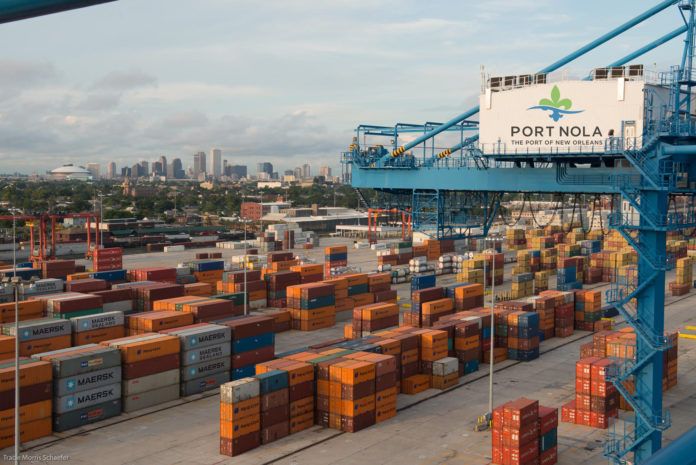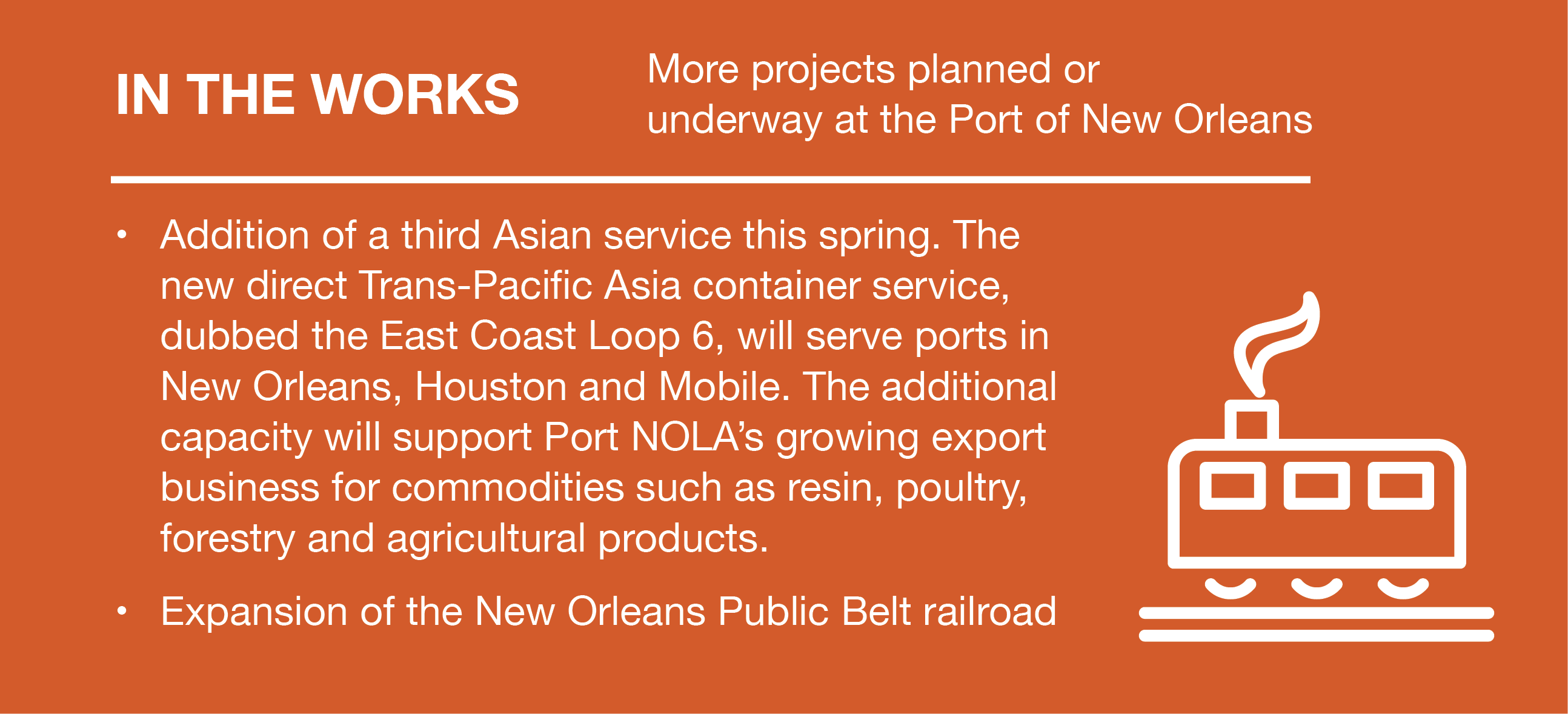When cruise ship traffic screeched to a halt and shipments dropped precipitously amid the COVID-19 pandemic, a sizeable chunk of the Port of New Orleans revenue stream instantly evaporated.
It sent even bigger shockwaves through the local economy, since cruise passengers account for about 300,000 hotel room nights each year in the Crescent City.
The pandemic literally shut everything down. “It was a bit of a blip in terms of our revenue trajectory,” says Port NOLA president and CEO Brandy Christian. “About 16 percent of our revenue comes from cruise traffic alone.”
Compounding the pain: Shipping volumes also dropped by more than 20% compared to 2019, forcing the port to take a hard look at its expenses, along with its short- and long-term plans.
The plastic resin market suffered the biggest drop in export traffic, although forest products, poultry and other were also impacted.
“When imports start slowing down, vessels don’t come to the port,” says Bobby Landry, the port’s vice president and chief commercial officer. “That means they don’t pick up our exports … and that’s our bread and butter. We’re primarily an exporter.”
Fortunately, Port NOLA’s fundamentals and long-term prospects remain unchanged, and shipping volumes have begun to return to pre-COVID numbers.
“If anything, COVID taught us the importance of getting goods onto grocery store shelves and into people’s homes,” Christian says. “It has led to a demand for greater flexibility in the supply chain, and that bodes well for regions such as New Orleans and Baton Rouge.”

Containers are king
Looking ahead, port officials are most excited about projected growth in the container side of the business. Port NOLA’s most significant current investments, in fact, will prepare it for the expected surge.
About $100 million has been allocated to expand the Napoleon Avenue Container Terminal, and in December the port moved forward with the purchase of 1,100 acres from the St. Bernard Port for a long-planned, $1.5 billion second container ship terminal in Violet.
“We see a huge opportunity to be a major player in the container distribution game, given our access to river, road and rail,” Christian says. “Ports that bring in a lot of import containers are heavily congested, so that gives us an advantage.”
Even amid the pandemic, Port NOLA knew it couldn’t postpone the work in St. Bernard.
The land purchase there kicks off a lengthy two-year period of due diligence to assess the project’s feasibility and potential environmental impacts, followed by several years of design and construction. “We had to remain aggressive to keep it on track,” Christian says.

The work at St. Bernard is a vital of Port NOLA’s long-range plans, and could eventually attract assembly or manufacturing operations, along with regional corporate offices.
“For years, we’ve had companies wanting to do business close to the port, but they couldn’t because we don’t have the land,” Landry says. “At St. Bernard, there will likely be a lot of ancillary private development to support the cargo business.”
Port officials describe it as undoubtedly be a game changer. “If you look at the growing population and GDP growth, every shipper and container carrier is trying the find the cheapest and fastest way to get into the south and Midwest,” she adds. “We provide a natural gateway to those markets by both rail and river.”
Once complete, the new terminal will complement the Napoleon Avenue terminal expansion by eliminating air draft restrictions (due to bridges) and providing 50-plus-foot-deep river drafts for larger vessels.
The current deepening of the Mississippi River by the U.S. Army Corps of Engineers will make it even more attractive, as it will support drafts needed by large Panamex-
style ships. The Corps expects to spend $45.7 million on the deepening project in fiscal year 2021, which will be added to $85 million approved in the fiscal year 2020 budget.
In a prepared statement, Gov. John Bel Edwards says the river deepening will bring undeniable benefits. “The Corps believes that work will pay for itself quickly by bringing larger vessels and more commerce to our state,” Edwards says in the statement.
The deepening project also gives Port NOLA greater flexibility and a competitive edge over rival ports.
“At 50-plus feet, we’ll have the best infrastructure in the Gulf,” Christian says. “Houston has significant challenges in their channel and Mobile is limited to a 14,000 TEU ships. We’ll be able to beat that.”
Of course, the expansion at the Napoleon Avenue Container Terminal fills the most immediate need, as it will enable Port NOLA to support short-term volume growth. The project is on track to add four new 100-foot-gauge container gantry cranes by the end of 2021.
Current work consists of repairing the wharf substructure piles, replacing the fendering system, electrical upgrades near the wharf and extending the landside crane rail at Nashville Avenue Wharf C.
The Napoleon Avenue work will ultimately increase Port NOLA’s container capacity to 1 million TEUs. Four ship-to-shore gantry cranes are being fabricated in China with expected delivery to New Orleans in early June 2021.
With the new cranes, the facility will have a total of nine container gantry cranes.
“With this foundational infrastructure and the arrival of four new 100-foot gauge gantry cranes, Port NOLA’s terminal operator partners will be able to handle ships up to 10,000 TEUs much more efficiently,” Christian says. Port NOLA stands to gain 200,000 to 250,000 TEUs within five years as a result.
The port is also expanding its rail yard for the Public Belt Railroad.
That’s particularly important to the petrochemical industry, which periodically uses the rail yard for product storage. NOPB’s connections with six Class 1 railroads affords customers a direct connection to 132,000 miles of track serving all of North America, as well as provides a vital connection with ocean carriers.

More Changes Coming
Port officials are equally excited about growing interest among companies in regional warehousing and distribution, and they’re playing an active role in promoting its potential in southeast Louisiana.
“The pandemic caused many companies to re-evaluate their supply chains,” Christian says. “They’re getting away from just-in-time inventory systems and going to a more traditional system where they have at least a couple of days or weeks of goods in a warehouse.”
That bodes well for the ports, as they can easily access multiple modes of transportation. Port NOLA hopes to leverage its existing “container-on-barge” partnership with the Port of Greater Baton Rouge to tap into the market.
Some 16,000 containers moved through the Baton Rouge port in 2020—more than double the volume when the service began in 2017.
In the process, SEACOR AMH LLC transports empty containers from Memphis to Baton Rouge via barge to be loaded at the Port of Greater Baton Rouge with resin from area plants, then moves the loaded barges downriver to the Port NOLA for international transport.
“That partnership has created a system and opportunity for Baton Rouge and New Orleans to be major players in the distribution market,” Christian says. “We want to see if we can get both imports and exports running between the two cities.”
Another exciting addition at Port NOLA: A third Asian service is expected to arrive at the port this spring.
“The Alliance” launched a new direct Trans-Pacific Asia container service, dubbed the East Coast Loop 6, to serve ports in New Orleans, Houston and Mobile. The additional capacity will support Port NOLA’s growing export business for commodities such as resin, poultry, forestry and agricultural products.

“That’s a big win for us,” Landry says. “A lot of ports on the West Coast have a significant amount of congestion, so it’s not unusual for carrier services to start sending product to other ports where they think they can be worked more quickly and efficiently.”
He says new Middle Eastern and Mediterranean services might be next, as well as smaller services for African cargo. “There are a total of about 13 weekly services coming here that cover the globe–Europe, Asia, Central and South America–and we do a good job of getting goods where they need to go,” he adds.
Port NOLA is “export heavy,” which can make it attractive to certain markets. “Just like an airplane, these shippers like to be full in both directions,” he adds. “We’ve actually got cargo to give them to take back.”




